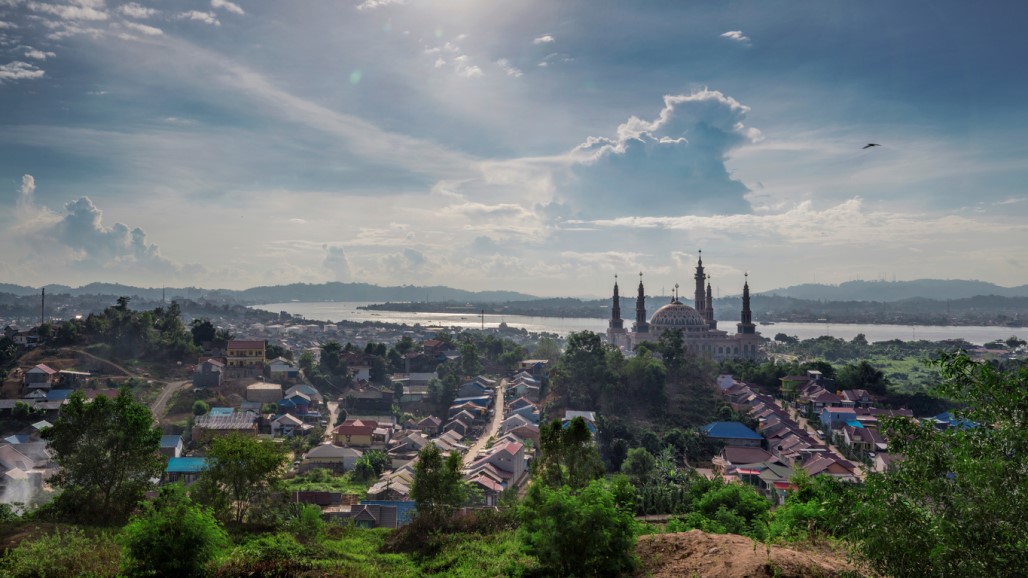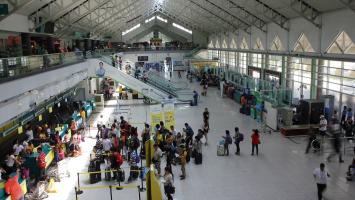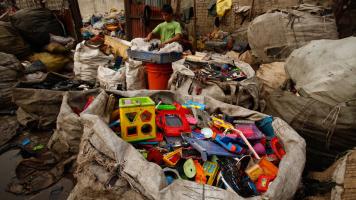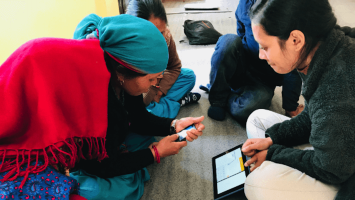
Nusantara is located roughly between two urban centers in East Kalimantan, Balikpapan and Samarinda (in photo). Photo credit: iStock/vidiawan.
The capital will be relocated to an area covered by BIMP-EAGA where it could help drive the subregion’s development and growth.
Indonesia is moving its capital to East Kalimantan on Borneo where it plans to build a green and smart city. The new capital, Nusantara, is 2,000 kilometers northeast of the current capital Jakarta on the densely populated Java Island. Its new location puts the administrative center of Southeast Asia’s largest economy right in the middle of BIMP-EAGA where it could help drive the subregion’s development and growth.
Indonesian President Joko Widodo said the government is reserving 70% of the new capital as green areas and will ensure environmental sustainability. This is in line with the country’s target of net zero carbon emissions and 100% new and renewable energy by 2060. He said the development of Nusantara will begin with “efforts to revitalize and reforest the forests. Then, we will develop basic infrastructure, green and blue areas of the city, government complexes, offices, and housing along with their facilities and infrastructure.”
The government also envisions Nusantara as a forest city since Kalimantan is a large area in what is known as the Heart of Borneo—rain forests that serve as the “lungs of the earth.”
A report from Antara said the government conducted a strategic environmental study, which recommends restoring tropical rainforest ecosystems as one of five roadmaps for environmental recovery and improvement.
In addition, the latest technology will be applied to the development of Nusantara to make it a smart city as part of the country’s 100 Smart Cities initiative.
Support from ADB
The Asian Development Bank (ADB) has pledged to help Indonesia plan its new capital as a carbon-neutral and inclusive city. ADB announced last Friday that it will help the Nusantara National Capital Authority (NNCA) design the new city, assess its potential environmental and social impacts, and mobilize financing from public and private sectors to support the city’s development. NNCA, the government agency in charge of planning and constructing the new capital, will also oversee the government’s transition to Nusantara and eventually become the city’s administrator.
“ADB looks forward to helping plan for the historic relocation of Indonesia’s capital from Jakarta to Nusantara,” said ADB Vice-President for East Asia, Southeast Asia, and the Pacific Ahmed M. Saeed during his 4-day visit to Indonesia last week. “Developing a brand-new city provides the unique opportunity to incorporate the latest thinking on what makes a city pleasant and efficient to live, work, and play. ADB will share international lessons learned to help NNCA design and fund construction of the new capital.”
As a first step, ADB will support NNCA’s effort to organize an international conference to learn how other countries have handled the development of carbon-neutral and inclusive cities.
“We thank ADB for its timely support as we move ahead with the development of Nusantara,” said NNCA Chairman Bambang Susantono, who until recently was ADB’s Vice-President for Knowledge Management and Sustainable Development. “There is substantial experience in creating carbon-neutral and inclusive cities elsewhere, and we are keen to work with ADB to understand these experiences and incorporate lessons learned.”
A focus on less developed areas
Moving Indonesia’s capital closer to the geographic center of the archipelago is expected to spur development in remote and less developed areas. In the past, infrastructure projects were concentrated on Java and Sumatra. To achieve sustainable and inclusive growth, development must spread out to other areas of the country.
The same purpose is behind the creation of the BIMP-EAGA subregion, which covers the entire sultanate of Brunei Darussalam; the provinces of Kalimantan, Sulawesi, Maluku and West Papua of Indonesia; the states of Sabah and Sarawak and the federal territory of Labuan in Malaysia; and the island of Mindanao and the province of Palawan in the Philippines. The four countries want to generate balanced and inclusive growth in areas that are less developed and geographically far from the national capitals, yet strategically close to each other.
BIMP-EAGA’s economy has become more vibrant since the initiative was launched in 1994. The subregion’s combined gross domestic product (GDP) in 2020 stood at $322.8 billion, up 12.36% from $287.3 billion in 2017. Though the COVID-19 pandemic affected the economy, its macroeconomic fundamentals remain robust.
The development of Nusantara may provide further impetus for the growth of BIMP-EAGA. It is expected to benefit other areas of the subregion in terms of economic spillover and market opportunities.
This article was first published by BIMP-EAGA on 29 March 2022.


